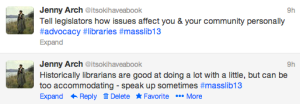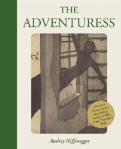On Thursday afternoon, I attended the session “Analyze Your Collection.”
“Collection analysis” in this case seemed to be a polite synonym for weeding (withdrawing books from the library collection). Two representatives from the Thomas Crane Public Library in Quincy, MA, Claudia Shutter and William Adamczyk (now of the Milton Public Library), spoke about their experience using the tool/service CollectionHQ. They described CollectionHQ as a “weeding/collection development tool” that “optimizes performance of materials”; CollectionHQ “talks” to the ILS monthly via FTP, so the library regularly sees new data.
Adamczyk spoke about the practical and ideal reasons for weeding. Practical reasons have to do with space, aesthetics, and cleanliness; “ideal” reasons have to do with updating the collection, keeping accurate statistics, and improving catalog searches. To get started, he said, (1) have a plan and goals and commit to it/them, and (2) form a team, then discuss, prioritize, and standardize.
Systematically weeding the library collection is “a great inventory project.” The hands-on aspect plus the CollectionHQ tool helped the Thomas Crane staff identify “dead items,” grubby items, and areas that were over- or under-stocked by comparing the items in the collection to the demand for those items. CollectionHQ also helped them maintain an accurate inventory and clean up their database. (Throughout the project, they used special red book trucks for weeding, so those carts wouldn’t be confused with regular circulation carts.)
Thomas Crane reported that their results after weeding and using CollectionHQ were “better circulation and better turnover, better aesthetics, better browsing, more space on the shelves…a better understanding of over/under-stocked areas.”
Next, we heard from Rick Lugg from Sustainable Collection Services. SCS “offers deselection decision-support tools to academic libraries.” Academic library stacks, Lugg said, are often “full of books but empty of users.” As he pointed out, it’s not free to keep a book on the shelf (see “On the Cost of Keeping a Book” by Paul Courant and Matthew Nielsen, p. 81-105, PDF), and so weeding – or “deselection” is necessary in academic libraries too. Lugg acknowledged that public librarians are “way out in front” of their academic counterparts in terms of weeding, but that academic libraries have a different mission than public libraries, and that mission includes preservation.
Lugg defined three categories of material: archive copies, service copies, and surplus copies. He spoke about redundancy, in terms of keeping a book on the shelf when it could be easily accessed elsewhere, either online (via HathiTrust or Google Books) or from another library. With “independent action in a collective context…safety is built into the system.” With SCS, libraries have the ability to “combine elements in a way that makes sense locally” and use the “rules-based interactive system” to make “data-driven decisions.” For example, a librarian could create a deselection list of withdrawal candidates that were published before 1990, have never circulated, and that are owned by at least 100 other libraries; these lists can be iterative, as weeding is “an ongoing process” rather than “one massive project.”
Overall, this was an okay session; though it was neat to see some of the CollectionHQ and SCS output, the session felt a bit like an advertisement, and I’m already very much on the weeding bandwagon for both “practical” and “ideal” reasons here at the public library. It was interesting to consider the additional parameters that academic librarians have to consider when weeding, though.
The final panel I attended at MLA on Thursday was “Print and Digital Publishing: How are Publishers, Editors, and Authors Adapting,” moderated by Skip Dye of Random House, with Liz Bicknell of Candlewick Press, M.T. Anderson (author of Feed and many other young adult novels), Amy Caldwell of Beacon Press, and Chris Stedman (author of Fathiest).
Skip Dye began by asking the question, “Adapting?” and answering it, “Are we?” The basic cycle of the publishing industry hasn’t changed: authors find agents, agents pitch the book to editors at publishing houses, publishers acquire the book and distribute it to the market. Within that cycle, however, there’s a lot of room for difference. Some editors still prefer to mark up a physical manuscript with pen or pencil (“I think with a pencil in my hand,” said Bicknell), while others will make corrections and suggestions on an electronic copy of the manuscript and e-mail it back to the author. Some editors – at Scholastic, for example – work entirely over e-mail, Anderson said, but that changes the revision process, not the writing process. At Candlewick, Bicknell said, books are still “conceived as print books,” then made “e.” Caldwell said she preferred to edit shorter pieces electronically, but still preferred to read long books on paper, for the better sense of cohesion and pacing.
The two really disruptive elements to the publishing industry at this moment are e-books and self-publishing, and those topics made up most of the panel’s discussion in this session. The editors and authors on the panel made many salient points about how e-books affect publishing in ways large and small. Caldwell pointed out that “it does take work to make a book into an e-book”; Bicknell explained that permissions were tied to the number of copies published, so even though e-book sales are not connected to physical quantity, they can be limited by permissions. “Trade publishing is a small profit margin business,” she said. Anderson, too, expressed concern about that margin. If advances continue to shrink, authors may no longer be able to afford to write research-intensive, sophisticated books – “Then what?”
Skip Dye raised a seemingly small but non-trivial point: permissions are necessary not just for other authors’ or artists’ work, but for fonts as well. Different e-readers and tablets display different fonts, and often offer only a limited choice. Bicknell added, “Fonts send subliminal messages…[they] create mood.” (Surely some readers of this blog are familiar with the documentary Helvetica? And we all have our favorite fonts…I am fairly certain I could identify a single line from an Ann Patchett novel based solely on the font.) Dye mentioned that different devices also display different levels of color saturation, which has an effect on illustrated books, especially children’s books.
The discussion then turned to self-publishing. Chris Stedman is a 26-year-old active blogger, a digital native who writes and edits on the computer, and reads and writes on paper – yet he still chose to write a book and work with a traditional publisher instead of self-publishing. He said that the value of a traditional publisher lies in the “third-party perspective,” an editor’s experienced eye instead of a friend or family member’s opinion. Caldwell spoke about the author-publisher match, describing publishers as “curators in certain areas.” (Beacon Press, for example, is “an independent publisher of serious fiction and nonfiction.”)
On the topic of self-publishing, Caldwell said, “Publishers can be wrong, and not want to take risks. But, editors see lots of manuscripts and know how hard it is to write a good book. There’s so much stuff, finding something you want to spend time with is hard….Publishers make it easier for readers to find something worthwhile.” Anderson too chimed in, agreeing that self-publishing allows for “democratization” but asking, “How do you end up with the grassroots but not the dirt?” Whereupon publishers were compared to the “special environment” of hydroponics.
 During the Q&A, Stedman stated, “The way in which we consume media is changing dramatically.” Writers are trying different formats (might we see a resurgence of the long-form essay, or the novella?). Caldwell mentioned the attention span issue; with the proliferation of information (and entertainment), shorter formats like “singles” or long articles might do well.
During the Q&A, Stedman stated, “The way in which we consume media is changing dramatically.” Writers are trying different formats (might we see a resurgence of the long-form essay, or the novella?). Caldwell mentioned the attention span issue; with the proliferation of information (and entertainment), shorter formats like “singles” or long articles might do well.
This final panel might have been trying to cover too much ground in its allotted time, but the panelists certainly touched on a number of interesting topics. As a former assistant at a literary agency, I can attest that about 99.98% of manuscripts submitted were nowhere near the quality of a published book, and even with help from an agent and an editor, most of them never would be. (Which is not to say that awful books don’t get published – they do – or that worthwhile manuscripts don’t get rejected – they do.) Whatever else changes, editing is a crucial part of the writing and publishing process.































